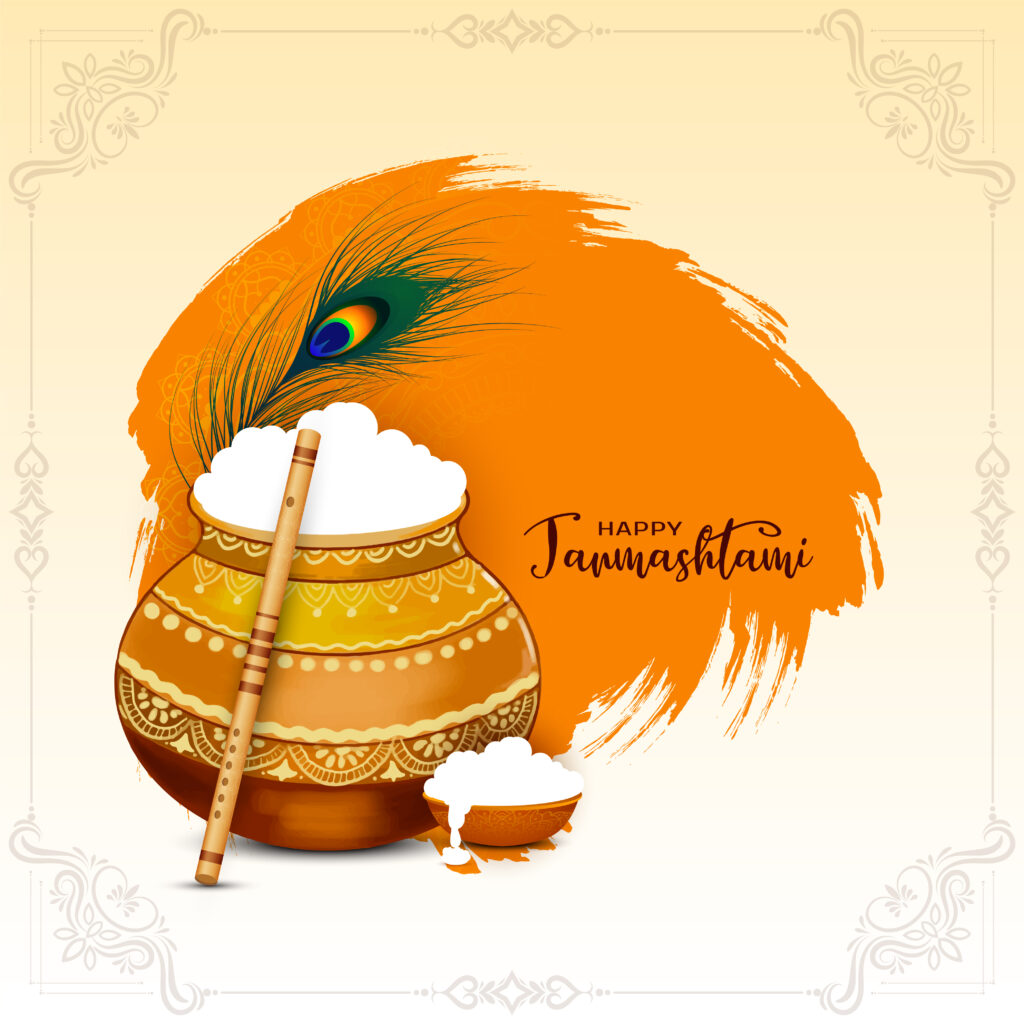Janmashtami, also known as Krishna Janmashtami, is a vibrant and joyous Hindu festival celebrating the birth of Lord Krishna, the eighth incarnation of Lord Vishnu. This festival is deeply rooted in Hindu mythology and tradition, and it is celebrated with immense fervor and devotion across India and other parts of the world.
Janmashtami falls on the eighth day (Ashtami) of the Krishna Paksha (dark fortnight) in the month of Bhadrapada, according to the Hindu lunar calendar. The festival typically occurs in August or September, and its celebrations are characterized by vibrant rituals, devotional singing, dancing, fasting, and reenactments of scenes from Krishna’s life.

Janmashtami marks the birth of Lord Krishna, who is one of the most beloved deities in Hinduism. According to Hindu scriptures, Krishna was born in the Dwapara Yuga, about 5,000 years ago, in a prison cell in Mathura. His birth is celebrated as a symbol of the victory of good over evil, as Krishna was born to kill the tyrannical king Kansa and to restore dharma (righteousness).
Divine Playfulness (Leela): Krishna is often depicted as a playful and mischievous child, and his playful acts, known as “leelas,” are celebrated with enthusiasm. These include stealing butter (which is symbolically interpreted as his love for his devotees) and his playful interactions with the Gopis (milkmaids) of Vrindavan. His leelas are a reminder of the joy, love, and simplicity of life.
Philosophical Teachings: Krishna is not just a mythological figure but also a profound philosopher. The Bhagavad Gita, a 700-verse Hindu scripture that is part of the Indian epic Mahabharata, is a conversation between Krishna and the warrior Arjuna. It contains essential teachings on duty, righteousness, and the nature of life and death. Janmashtami is an occasion to reflect on these teachings.Celebration of Devotion: Janmashtami is a festival of devotion and love. Devotees fast, sing devotional songs, and participate in Dahi Handi competitions, where teams form human pyramids to break a pot of curd hanging high above the ground. This tradition is inspired by Krishna’s childhood activities and symbolizes the breaking of ego and ignorance to attain divine wisdom.
How Janmashtami is Celebrated :-
Fasting and Night Vigil :- Devotees observe a day-long fast, which is broken at midnight, the supposed time of Krishna’s birth. The fast is considered a form of penance, purifying the body and soul.
Jhankis and Rasleela :- Jhankis are decorative displays or tableaux depicting scenes from Krishna’s life. Rasleela, a traditional dance-drama, is performed to retell the divine love story of Krishna and Radha.
Dahi Handi :- In Maharashtra and other parts of India, the festival is marked by the Dahi Handi event, where a pot filled with curd (dahi) is hung at a height, and teams of young men form human pyramids to break it. This event symbolizes Krishna’s playful and mischievous nature, particularly his love for butter.
Midnight Celebrations :- Janmashtami is celebrated at midnight, as it is believed that Krishna was born during the darkest hour of the night, symbolizing the dispelling of darkness (ignorance) by light (knowledge).
108 Dishes :- In many households, 108 different food items are prepared as an offering (bhog) to Lord Krishna. This number is considered auspicious, representing the 108 beads in a Hindu mala (rosary).
The Chappan Bhog :- In Vrindavan and Mathura, a grand offering of 56 food items, known as Chappan Bhog, is made to Lord Krishna. This tradition stems from the belief that during his childhood, Krishna consumed eight meals a day. When he lifted the Govardhan Hill to protect the villagers from a storm for seven days, he missed 56 meals (8 meals × 7 days). The Chappan Bhog is offered to compensate for these missed meals.
Global Celebrations :- Janmashtami is celebrated by Hindus worldwide, with major festivities in countries like Nepal, Fiji, Trinidad and Tobago, and even in Western countries with significant Indian diaspora, like the United States and the United Kingdom.
Butter and Krishna :- The association of Krishna with butter is deeply rooted in his childhood stories. It is said that Krishna loved butter so much that he would often steal it from his mother Yashoda and other village women. This is why butter is a central element in many Janmashtami rituals, including the Dahi Handi.
